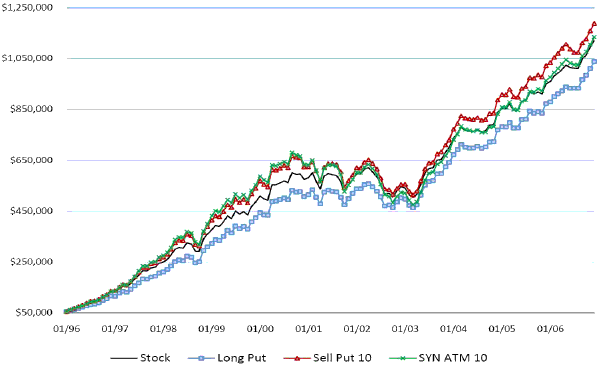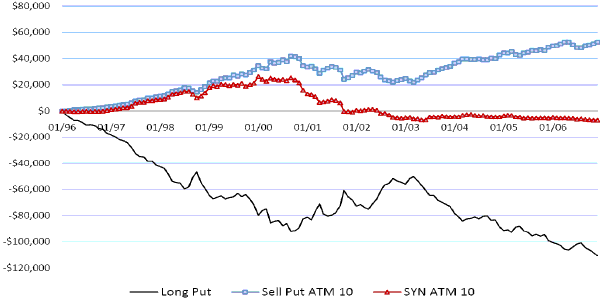Are there ways that individual investors can systematically use options for individual stocks to enhance portfolio returns? In their September 2007 paper entitled “Firm Specific Option Risk and Implications for Asset Pricing”, James Doran and Andy Fodor examine the benefits and costs of 12 basic strategies for augmenting an initial investment in a group of stocks with systematic investments in the associated options. Options positions are initially 75-90 days to expiration and held to maturity. For each strategy, the authors test sensitivity to the size and moneyness (at the money, in of the money and out of the money) of options investments. Using stock and option prices and associated firm fundamental data for the 213 companies over the period 1/96-7/06, they conclude that:
- Firms with sufficient options data tend to be large growth firms.
- No long options strategy outperforms the stock-only benchmark portfolio over the entire sample period. Even in a bull market, long call option positions offer little to no portfolio enhancement, and the risk reduction of puts does not offset the costs of purchasing them.
- For long option strategies, the further out of the money the initial position, the worse the performance. However, the converse that short option strategies improve by starting further out of the money does not necessarily hold, because higher percentage bid-ask spreads limit profitability.
- There can be some net benefit from selling calls when the leverage used is high enough to overcome transaction costs.
- There can be significant positive net benefit from selling puts, again depending on amount of leverage used. Investors will pay a premium to hedge against firm-specific price drops.
- Returns from option strategies have little to do with firm characteristics such as momentum, size, book-to-market and implied volatility, suggesting a pervasive premium for puts.
- Other tests indicate that gains from selling puts relate to idiosyncratic (stock-specific) volatility and not market volatility.
The following chart, taken from the paper, shows the cumulative dollar values of four value-weighted portfolios constructed from the entire sample of stocks, as follows:
- Stock-only portfolio (Stock)
- Stock and long at-the-money (ATM) put portfolio (Long Put)
- Stock and short ATM put portfolio using up to 10% of portfolio value for puts (Sell Put 10)
- Stock and synthetic stock (long calls and short puts, both ATM) portfolio using 10% of portfolio value for the synthetic position (SYN ATM 10).
Initial investment is $50,000 in stocks, and the monthly incremental investment during 1/96-7/06 is $5,000 in the either the stocks or associated options that are three months from expiration. There is a distinct advantage to selling puts and a roughly equal penalty to buying puts. Even during the very bullish 1996-1999 period, there is little benefit to holding call options. The portfolio augmented by a synthetic stock position beats the stock-only portfolio by a maximum of just 8% in early 2000, driven by the benefit of selling puts. After 2003, the synthetic augmentation strategy underperforms the short put strategy because of the drag of buying calls.

The next chart, also from the paper shows the cumulative dollar value of three value-weighted portfolios constructed from the entire sample of stocks, relative to the stock-only portfolio, as follows:
- Stock and long ATM put portfolio (Long Put)
- Stock and short ATM put portfolio using up to 10% of portfolio value for puts (Sell Put 10)
- Stock and synthetic stock portfolio using 10% of the portfolio value for the synthetic position (SYN ATM 10).
Initial investment is $50,000 in stocks, and the monthly incremental investment during 1/96-7/06 is 10% of the portfolio value in either stocks or associated options that are three months from expiration. Returns are adjusted for monthly investments such that the cumulative value represents only the return from the initial $50,000 investment. The figure demonstrates that, using constant option leverage, selling (buying) puts outperforms (underperforms) the stock-only portfolio. It also emphasizes that synthetic stock profitability is driven by selling puts. After 2001, the long call part of the synthetic position actually eliminates the profit from selling puts.

In summary, investors are willing to pay a premium to protect themselves from crashes in individual stocks. Systematically selling puts on individual stocks, with sufficient leverage, can enhance equity portfolio performance.
For diversification purposes, individual investors may prefer to capture the fear-of-crash premium via index put options rather than firm-specific puts.